The camera is capable of shooting in Aperture-Priority AE and in a switchable full manual mode.
The OM-2 also laid claim as the first (and still the only one) system camera with a super accurate center-weighted TTL (Through-the-Lens) Direct (Off-the-Film) Light Measuring System.
Upgrades and revisions saw the OM-2 being updated to the OM-2 MD, which came with motor-drive adaptability, and the OM-2n in 1979 with advanced TTL flash capabilities, making possible new circuitry and additional contacts for the Shoe 4.
Other improvements include a flash-ready light in the viewfinder, a contact point for the Recordata Back, and a re-contoured film advance lever. Shoe 4 is, however, not backward compatible.
Built on the same technical platform as the OM-1, the OM-2 places itself as a better option for photo enthusiasts and as a painless upgrade, as it is compatible with all of the OM system's options and accessories that were already available. Still valid today, fun, and enjoyable to use, the camera is as good as it was meant to be.
Introduction to the Olympus OM-2N (OM-2n), Video 1 of 2
Olympus revealed the OM-2 to the world as a prototype at Photokina in 1974. The OM-2 arrived, over its life, in three key varieties -- the OM-2, the meter-improved OM-2n, and the OM-2s. Of the three, the OM-2n represented the best combination of features, functionality, and reliability.
Design and Build
The Olympus OM-2n is a 35mm Aperture-Priority AE SLR camera with an electronically controlled cloth focal plane with a shutter speed range from 120-1/1000 second under TTL (Off-the-Film) Direct Light Measuring System, and 1-1/1000 second, and B, under TTL (Off-the-Film) Direct Light Measuring ring-mounted manual control.Exposure compensation is at +2EV in 1/3 steps, the film ISO speed is 12-1600, a 4-12 second delay self-timer, and the standard screen is an interchangeable Microprism/Matte type, with 14 screen type options. The camera back is a removable hinge type, with a film tab holder, interchangeable with Recordata Backs, and a 250 Film Back.
The Heart of the Camera
This OTF (Off-the-Film) metering was the first implementation of its kind ever.
Basic Camera Features
The Olympus OM-2n is available in both elegant chrome and charming black.The front of the camera is simple and straightforward, with the proportionally large lens mount housing and the integral shutter speed ring occupying, slightly off-centered to the right, the front plane of the camera. To the left, bordering the top plate and the body plate, is the Rewind Release Lever, with the Self-Timer located directly below it on the lower half of the panel. To the right, the front plane is plain, aside from the FP and X Flash Sync sockets located on the vertical of the lens mount.
The top of the camera is where all the controls are. The leftmost is the singularly alone Film Rewind crank. To its right is the Manual / Off / Auto selector switch with a push-up option for the three-stage battery check (Full Voltage, Depleted, Exhausted).
The back of the pentaprism houses the socket and connector points for the hot shoe. On the right is the combined ISO and Exposure Compensation dial, the Shutter Release button, the Film Forward crank, and the auto-reset Film Counter window.
Again, an all-black affair for the back of the camera, except for the viewfinder window and battery-check LED light.
Located on the bottom plate of the OM-2n are the Battery Chamber cover, Motor Coupling Socket (with cover), Motor Guide Pin Hole, Tripod Socket, and Motor Coupling Terminals.
Film loading and unloading is a no-frills Olympus Easy-Load system. The film box, with the film chamber, guide rails across the shutter curtain window, sprocket, and the take-up spool, is something a newbie may need to get used to.
Viewfinder Readout
Nothing is displayed when the Auto Selector Switch is in the Off position. The displays are detailed in the next section.
Exposure Modes
Aperture-Priority AE [AUTO] - Recommended as the most convenient and easy-to-use shooting mode on the Olympus ON-2n. Set the Mode Selector Lever to Auto, preset the lens aperture you want to take the picture in, and the camera will calculate the shutter speed automatically. Variations of the lighting condition will be adjusted automatically by the Off-the-Film Direct Light Measurement System.
Manual Exposure Mode [MANUAL] - In Manual Exposure mode, you control both the lens aperture and shutter speed. You can choose to:
- Pre-set the aperture opening for Aperture Preferred Manual Exposure Control, or
- Pre-set the shutter speed for Shutter Priority Manual Exposure Control
Mirror Lock-Up
The only 'nay' that I can say of the OM-2n is that it does not have a mirror lock-up function.Battery
The Olympus OM-2n requires a pair of SR44 (recommended) or LR44 (I use these) cell batteries to power the camera's AE system. While the SR44s are more stable with a steady voltage output, I do change the pair of LR44s more often than most.Battery Check
The battery check is activated by the Auto Selector Switch located on the top plate of the camera - a three-stage LED light display - Continuous (Full Voltage), Intermittent (Depleted, needs replacement), None (Exhausted, replace).Camera Body Weight
The body weight of the OM-2n is 520 grams without batteries.The Heart of the System
As a system camera body, the OM-2n is also central to a vast array of interchangeable system components that can be shared freely with OM-1 system bodies, as well as other forthcoming bodies, of course.These accessories are divided into various photo groups and range from the Zuiko Interchangeable Lens Group, the Finder Group, the Flash Photo Group, the Motor Drive Group, the MacroPhotography Group, the PhotoTechnical Group, the PhotoMicroPhotography Group, and the Case Group.
Using the Camera
I must admit that I am a bit of an Olympus freak, having owned and used the OM-1 MD, OM-2n, OM-2S, and OM-4, which are now part of my cherished collection. On the digital side, I use an E-520 and E-620 for product shots and a Pen E-P5 as a regular. Back to the analog SLR side, the OM-2n was my favorite, superseded now by the Spot Meter and Programmed AE OM-2S.Being compact and complete was the dictum I used when I started out with the OM-1 MD. The OM-2n, which measures 136 x 83 x 50mm and weighs 520 grams, is nowhere bigger or heavier. With a Zuiko Auto-S 50mm f/1.8 lens mounted, the OM-2n was only 31mm deeper and 140 grams heavier. The camera's excellent built quality adds to its solid feel and robust handling aptitude, which is a joy to use and behold.
What I remembered most is the very subtle and soothing 'clunk-and-thump' of the mirror slap and shutter actuation, which is reassuringly different from any other camera that I have used and tested. The ability of the TTL (Off-the-Film) Direct Light Measuring System is something you have to see and appreciate, on a camera body that has all the knobs, buttons, and levers located within the reach of your fingers, just right where they should be.
Focusing is easy, thanks to the big and very bright viewfinder. The interchangeable screen system makes it worthwhile for you to go beyond the norm, be it in astrophotography, architecture, or macro photography. Metering is, of course, almost perfect; even shooting from the hip, or street style, even with the mode selector turned to 'OFF', will still give you near-perfect exposures.
Olympus Zuiko lenses, known for their stellar image quality, are just as important in the equation. Consummately small and compact, these lenses have their aperture ring up front, swapped with the focus ring if you were to compare them to the likes of others (Nikon, Pentax, Minolta). Each lens comes with a depth-of-field preview button ...
Enough said!


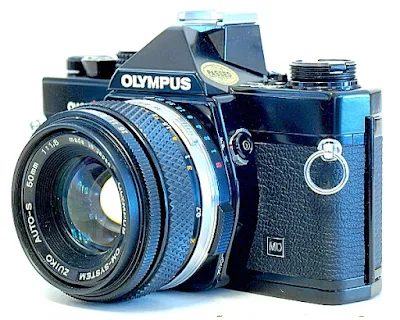



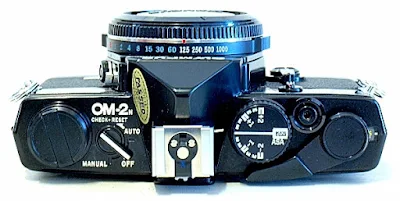


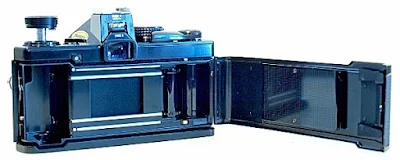
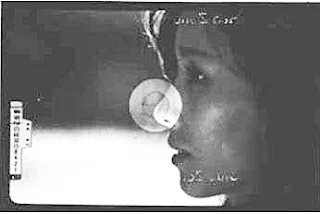

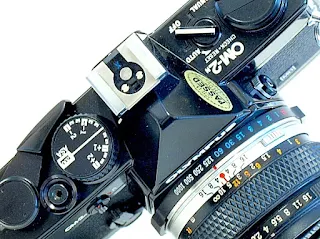

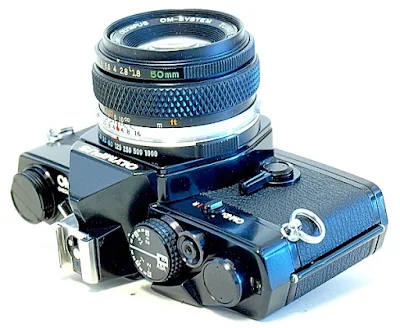











Estimado. ¿Como mide esta camara? Metering modes of de camera?
ReplyDeleteAny help from other readers? Thanks.
DeleteActually the Zenza Bronica "i" versions of the medium format cameras ETR-Si and SQ-Ai models have OTF metering too, May also be on the GS-1 but as I don't own one of those I am not sure.. Used to control dedicated flashes and during regular exposures
ReplyDeleteLovely cameras! The Pentax LX, introduced in 1980, has OTF dynamic metering too. There were some beautiful iconic cameras made in that era (second half of 1970's).
ReplyDelete